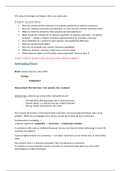50% about knowledge and insights, 50% as an advice plan.
Exam questions
Write the outline and the elements of a customer experience to enhance conversion.
How can I enhance conversion and retentonn so I can close the customer experience loop?
What are the three elements of the customer journey/experience?
What should this company do to improve acquisitonn to improve conversion / to improve
retenton --> design a simple e-commerce approach about for example a web shop
Give a defniton of e-commerce and e-business and explain the diference
What are the big trends today?
How can you evaluate your current e-business capabilites?
Diference between a business model and a revenue model?
Which elements defne an OVP (online value propositonn? Know at least 3!
Create a customer journey in the case in the exam, with touch points!!!
Introduction
Brand (product/service, value oferr
Strategy
Engagement
Measurement (the tote loop = test, operate, test, evaluate)
Internet risks- what can go wrong with a transactonal site?
- Site downtme afectng whole site or some processes
- Security atack, e.g. denial of service, content hijacked
- Wrong content presented for site visitor
The moment the brand is in the head of fnal consumers, you have brand preference and a 'brain
positon'. When you are engaged with a brand, you get the evoked set and a preference
Fundamental of marketng -->
customer experience: acquisition --> conversion --> retainment/retention
E-commerce is the same as traditonal business, but you use internet related technology to reach the
customer (an enablerr.
A part of digital business is E-commerce. --> all about conversion (can be money wise, or informaton
wiser
The moment there is a fnancial transacton, then we talk about e-commerce.
E-commerce is every moment a certain conversion or transacton takes place (e.g. even when
downloading an online documentr.
,What is happening in today's world, all small companies will be eaten by the big ones (such as
Amazon, Alibabar --> tectonic shifs
Two ways to fnd an answer:
Algorithmic way (always an answerr
Heuristc way
Start of E-business in 2000.
The impact of electronic communicatons on traditonal business
The impact and tme to react varies by sector
Andy Grove, Chairman of Intel, one the early adaptors of e-commerce, has made a
meteorological analogy with the internet.
Chapter 1
Digital technology drives business change --> internet is changing people
Main trends today: privacy – transparency, voice control (sirir, face recogniton.
Sales > narrow defniton: money for goods
Sales > broad defniton: something for something, conversion. (e.g. informaton wise such as
Facebookr
Internet was 'designed' during the cold war as a communicaton tool for military
Customer journey/experience (--> platormr
1. Acquisition
2. Conversion
3. Retention
Reach and richness gives a beter customer journey. Because of reach you a fnd solutons. Because
of richness of informaton around it is enriching me/triggering me.
E-business opportunites (company point of viewr
Reach
o Over 4.0 billion users globally
o Connect to millions of products
Richness
o Detailed product informaton on 20+billion pages indexed by google, video's etc
o Personalized messages for users
Affiliation
,Thee defnitons of the relatonship between e-commerce and e-business
E-commerce has some overlap with e-business
E-commerce is broadly the same as e-business
E-commerce is an inner course of e-business
The moment you know the customers, you can create persona's.
Sell-side e-commerce
Transactonal e-commerce sites
Services-oriented relatonship-building
Brand-building sites
Portal, publisher or media sites
Social network
Six types of digital media channels; online communicaton techniques for e-commerce -->
Omni channel / multi-channel
1. Search marketng
2. Online PR
3. Online partnership
4. Interactve ads
5. Opt-in email
6. Social media marketng
Offline communicaton techniques
Advertsing
Personal selling
Sales promoton
PR
Promoton
Direct mail
Exhibiton
Events
Word-to-mouth
Sponsorship
Packaging
Evoluton of web technologies --> web 2.0
web services, interactve applicatons (google mapsr
Supports community partcipaton (Facebookr
User generated content (blogs, Instagramr
Content raton and online services (TripAdvisorr
, Ad funding of neutral sites (Gmailr
Data exchange between sites (rssr
Use of rich media
Rapid applicaton apps
NO privacy
9 basic platorms: b2b, b2c, b2g, c2c, c2g, c2b, g2b, g2g, g2c (sheet 50r
Drivers of business internet adapton (1r
Driven by benefts to diferent parts of the organizaton:
Impact on proftability
Generaton value
o Potental for increased revenue arising from...
o Increased reach to a larger customer base
o Encouraging loyalty and repeat purchase
o Cost reducton
Barriers set-up costs, running costs, lack of tme/resources, lack of skills by the staf
Stage model and OVP
Stage models are used to access future development of e-commerce strategy.
--> Firms need a clear online VALUE PROPOSITION (OVPr (they contain the 6 C'sr
Chapter 2
6 C's – diferent types of customer value
1. Content (relevant, rich content, content is kingr
2. Customization (mass customizaton, Amazon recommendsr
3. Community (forums, chatrooms, blog commentsr
4. Convenience (anytme, 24/7r
5. Choice (wider choice in products, suppliers, pricesr
6. Cost reduction (low cost place of purchaser
OVP = Online value propositon. The 6 C's defne the online part of your value propositon. They are
the indicator for a successful online value propositon.
A statement of the benefts of online services reinforces the core propositon and difereniates form
an organizaton's offline ofering and those of compettors.
In the end there is no distncton in what you ultmately ofer.
Disintermediation: the removal of intermediaries, such as distributors/ brokers that formely linked a
company to its customers.




